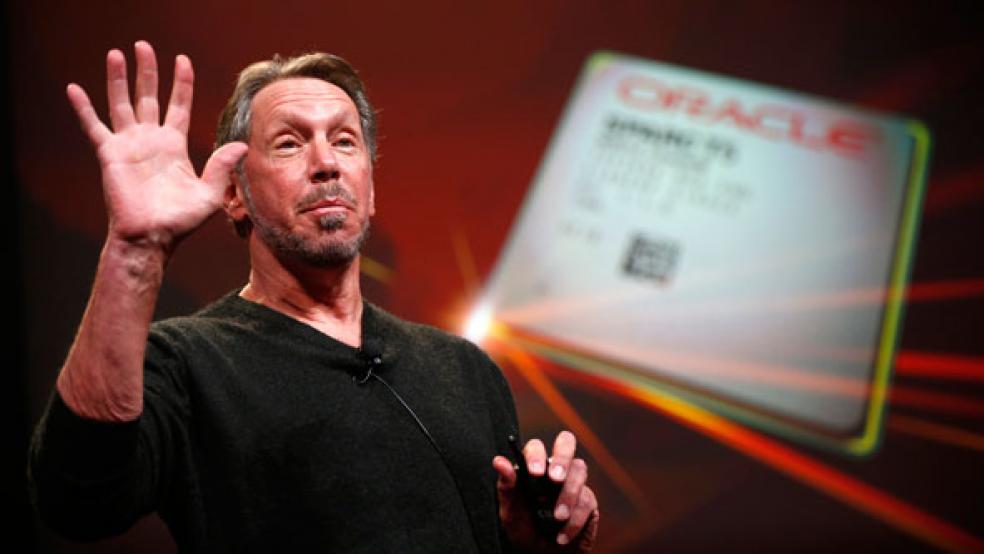You could construct an all-star roster of high-flying, highly paid CEOs who were brought back down to earth in 2012: J.C. Penney’s Ron Johnson. JPMorgan Chase’s Jamie Dimon. Even Apple’s Tim Cook. All saw their pay cut sharply from 2011 levels, at least on paper. While the S&P 500-stock index climbed 13.41 percent (or 16 percent including dividends) and corporate profits continued to rise, that trio and a number of other high-profile CEOs did worse in 2012 than they had the year before.
Johnson, ousted as J.C. Penney’s CEO this month, and Dimon, whose bank endured the embarrassing London Whale trading fiasco, may be extreme examples, but CEOs of companies that didn’t suffer through headline-making stumbles also had their pay slashed. Revenue and profits fell at Morgan Stanley, resulting in a 20 percent cut to CEO James Gorman’s pay. Ford CEO Alan Mulally received nearly $21 million in total compensation last year – a healthy sum, to be sure, but about 29 percent lower than the $29.5 he got in 2011. Top executives at companies such as Chevron, Macy’s, Newell Rubbermaid and Sears also took pay cuts.
CEOs, for years, have been lavished with ever-increasing pay packages even as median incomes for workers stagnated. Might the gulf between the corporate 1 percent and the 99 percent be closing, if ever so slightly? The AFL-CIO’s annual Executive Paywatch report, released Monday, found that the ratio of average CEO-to-worker pay for 327 companies in the S&P 500 narrowed a bit last year, to 354 times from 380 times in 2011.
The average pay package for CEOs in the AFL-CIO analysis fell 5 percent from 2011. That and the litany of high-profile pay cuts last year suggests some progress has been made in tying pay to performance. “We are definitely seeing examples where, as companies just don’t perform as well you’re not seeing the pay numbers go up quite as much,” says Aaron Boyd, director of research at executive compensation data tracker Equilar.
The financial crisis focused increased attention on executive compensation, and the Dodd-Frank reform of 2010 gave investors increased influence through the Say on Pay rule, which requires public companies to put executive compensation plans to shareholder votes. “All of that has brightened the spotlight on pay and companies certainly I think are putting forth more effort and resources into ensuring that pay is aligned with performance,” says Boyd.
To better achieve that alignment, companies have also diversified the types of equity compensation used, with stock options being replaced by restricted stock grants and, more recently, performance-based awards gaining favor, according to Boyd. “We are seeing a lot of companies moving toward giving multiple or even all three types of equity vehicles as they are, a lot of times, looking to mitigate risk,” he says.
Other experts caution that it’s far too early to celebrate any significant progress, let alone herald a new era of accountability in executive compensation. “We have seen some changes, but we’ve got a long way to go,” says Nell Minow, an expert on corporate governance and co-founder of GMI Ratings, which analyzes shareholder risks. “The changes are quite marginal.”
Complete data on 2012 pay packages won't be in for a number of weeks, but an early analysis of top-earning CEOs indicates that their average compensation actually climbed, if at a slower rate than in prior years. In a study done for The New York Times, Equilar found that median compensation for the 100 highest-paid CEOs of large publicly traded companies climbed by 2.8 percent – “not much compared to double-digit growth we had seen in the some of the previous years,” notes Boyd.
Don’t shed any tears for the CEOs just yet; a less-generous raise is still a raise, after all. And the median pay package among those 100 top-paid CEOs totaled more than $14 million. (As part of that, the Times pointed out, the average value of perks received by the CEOs jumped 18.7 percent to more than $320,000 – and cash compensation rose nearly 20 percent.) The average compensation in the broader AFL-CIO report for 2012 totaled $12.3 million, and while the gap between CEOs and workers narrowed, it was still wider than it was as recently as 2010 – and far bigger than it was 30 years ago. The average large company CEO in 1982 made 42 times as much the average worker, according to the union.
Accurately calculating compensation for a given year can be tricky, and Cook provides a good example of that. He topped all CEOs in 2011, when he received $377.9 million in compensation. That chatter-inducing pay package included a huge stock award that vests over ten years, though. Last year, Cook got $4.2 million, all in cash, but he also reportedly vested in $140 million worth of stock granted while he was chief operating officer. So while his pay appears to have plunged, the swings are not nearly as large as they seem. If Cook’s pay is excluded from the AFL-CIO calculations, the average CEO pay would have increased 5 percent last year instead of falling 5 percent.
More importantly, if shareholders generally judged executive pay by return on investment – the same way a company might evaluate advertising or research costs – “we are still not doing very well,” Minow says. Examples of big pay cuts, while they may make for surprising headlines, don’t necessarily signal real change. “If somebody is getting paid $50 million and you cut his pay in half, he is still getting paid a lot of money,” Minow says. That doesn’t help align pay with performance.
Even Say on Pay votes have had limited effect, Minow says. The votes are nonbinding, so while they might occasionally prove embarrassing to companies or executives, they don’t necessarily result in real Sway on Pay. For example, the top-paid CEO of 2012, based on Equilar’s data, was Oracle CEO Larry Ellison. Fewer than half of Oracle’s shareholders approved of his compensation package, but Ellison still received $96.1 million (almost all in stock), up 24 percent from 2011. Ellison’s shareholders, at least, more than kept pace. They saw the value of their stock climb 30 percent over the course of 2012.
The Highest-Paid CEOs of 2012 | ||||||
| Executive Name | Company | 2012 Compensation | |||
| Lawrence J. Ellison | Oracle | $96.1M | ||||
| Richard M. Bracken | HCA | $38.5M | ||||
| Robert A. Iger | Walt Disney | $37.1M | ||||
| Mark G. Parker | Nike | $35.2M | ||||
| Philippe P. Dauman | Viacom | $33.3M | ||||
| John J. Donahoe | eBay | $29.7M | ||||
| Howard Schultz | Starbucks | $28.9M | ||||
| Stephen I. Chazen | Occidental Petroleum | $28.5M | ||||
| Kenneth I. Chenault | American Express | $28.0M | ||||
| Louis C. Camilleri | Philip Morris International | $24.7M | ||||
| Source: Equilar | ||||||





